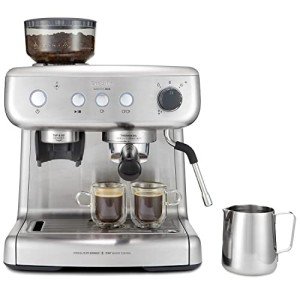Ten Myths About Stainless Steel Espresso Machines That Don't Always Hold
The Art of Italian Espresso Machines: A Brewed Tradition
Italian espresso machines are not just home appliances; they are an important part of Italy's abundant coffee culture, representing a blend of artistry, engineering, and design. Coffee fanatics around the world recognize the importance of high-quality espresso, a staple of Italian life and cuisine. This short article checks out the history, mechanics, types, and elements to consider when purchasing an Italian espresso machine, reflecting the depth of this cherished drink and its brewing approaches.
History of Espresso Machines
The espresso machine's development dates back to the early 20th century in Italy, where coffee was not simply a beverage but a vital social ritual. The preliminary attempts to brew espresso started with simple, stove-top designs, slowly developing into complicated machines that could reproduce the best brew.
- 1901— The First Espresso Machine: The first steam-powered espresso machine, understood as the “Ideale,” was developed by Luigi Bezzera. This machinery marked a turning point in espresso brewing.
- 1938— The Lever Machine: The intro of the lever machine made it easier to manage the pressure utilized in espresso extraction, boosting taste consistency.
- 1947— The Automatic Machine: Reaching more consumers, Gaggia released the very first automatic espresso machine, additional popularizing espresso bars.
- 2007— The Digital Age: Technological advancements led to the birth of completely programmable machines, allowing users to tailor their brewing settings to attain a tailored coffee experience.
Secret Features of Italian Espresso Machines
Italian espresso machines embody precision, craftsmanship, and innovation. Here are some crucial parts that highlight their significance:
Feature
Description
Boiler Type
Identifies how heat is produced and kept. Common types consist of single boiler, dual boiler, and heat exchanger.
Group Heads
Where the coffee is brewed; commercial machines typically have several group heads for efficiency.
Pressure Control
Crucial for accomplishing the best espresso; most machines operate at 9 bars of pressure.
Frothing Capabilities
The steam wand permits for milk frothing, important for drinks like cappuccino and latte.
Develop Quality
The materials utilized (stainless steel, brass, etc) influence sturdiness and heat retention.
Kinds Of Italian Espresso Machines
Picking the best machine hinges on user preferences, budget, and meant use. Below are the primary kinds of Italian espresso machines:
Manual Espresso Machines
- Pros: Offer full control over the brewing procedure, permitting a customized touch.
- Cons: Require skill and practice, can be labor-intensive.
Semi-Automatic Machines
- Pros: Provide a balance between automated and manual procedures; users control water flow.
- Cons: Can have a steeper knowing curve than completely automatic machines.
Totally Automatic Machines
- Pros: Simplify the brewing procedure with push-button operations; suitable for beginners.
- Cons: May compromise some of the subtleties of manual brewing.
Super-Automatic Machines
- Pros: Grind, tamp, brew, and froth automatically; hassle-free for hectic way of lives.
- Cons: Less control over the developing variables, capacity for a less authentic espresso experience.
Buying Guide: Factors to Consider
Selecting the perfect Italian espresso machine can be daunting, but considering the following aspects can streamline the decision-making procedure:
- Budget: Italian espresso machines vary from affordable to high-end designs, so set a budget upfront.
- Usage Frequency: Evaluate how typically you will use the machine; daily users may want a more durable choice.
- Area: Measure your cooking area or counter area; some machines can be large and require enough clearance.
- Maintenance: Consider ease of cleaning; machines with removable parts or integrated cleansing features may lower maintenance.
- User Skill Level: Beginners might choose completely or semi-automatic machines, while knowledgeable baristas can handle manual machines.
- Brand Reputation: Research brands known for quality, such as Breville, Gaggia, and La Marzocco.
Popular Italian Espresso Machine Brands
Italian workmanship is renowned for producing some of the best espresso machines worldwide. Here are top brands worth considering:
- Gaggia: Known for its home espresso machines and price.
- La Marzocco: An exceptional brand understood for its commercial-grade machines and ingenious innovation.
- Rancilio: Renowned for its resilient develop and professional-quality machines appropriate for home and commercial use.
- Sage/Breville: Offers advanced features and easy to use designs, best for both novices and enthusiasts.
FAQs
What is the difference in between espresso and routine coffee?
Espresso is a concentrated coffee brewed by forcing hot water through finely-ground coffee under pressure. It has a thicker consistency, richer flavor, and higher caffeine concentration than regular coffee.
Can I make milk-based drinks with an espresso machine?
Yes, numerous Italian espresso machines feature a steam wand to froth milk for drinks like cappuccinos, lattes, and macchiatos.
How typically should I clean my espresso machine?
Routine maintenance is vital. Typically, Office Espresso Machines is advised every couple of weeks, while descaling ought to be done every 1 to 3 months, depending on water hardness.
What is the perfect pressure for brewing espresso?
The perfect pressure for developing espresso is around 9 bars. Office Espresso Machines ensures the ideal extraction of tastes from the coffee grounds.
Are more expensive machines worth the financial investment?
Higher-end machines often make use of better products and innovation, supplying enhanced sturdiness and more consistent results. For serious coffee enthusiasts, purchasing an excellent machine can elevate the espresso experience significantly.
Italian espresso machines are far more than simple developing devices; they are a celebration of a cultural tradition that has actually affected coffee intake worldwide. With various designs readily available to fit any user's needs— ranging from beginners to seasoned baristas— there is an Italian espresso machine perfectly fit for everybody. As you start your espresso journey, comprehending the history, mechanics, and options will enhance your experience and appreciation for this time-honored beverage. Whether you seek to recreate a café atmosphere at home or fine-tune your developing method, these machines are capable of providing memorable cups of espresso adorned with the rich history of Italian coffee culture.
